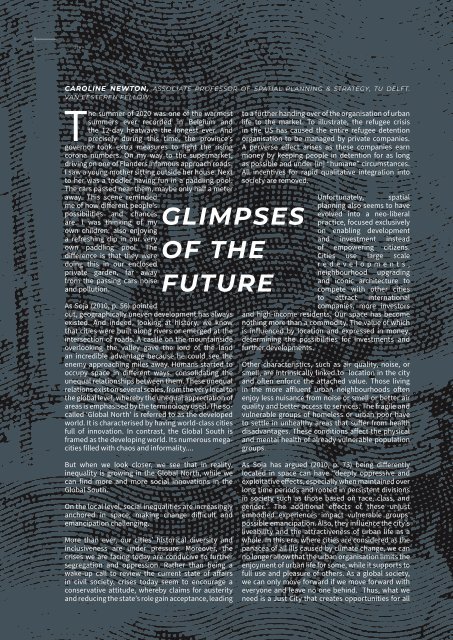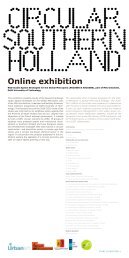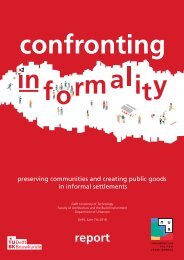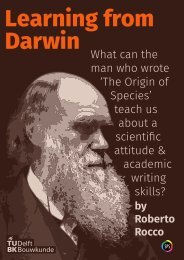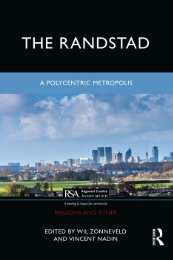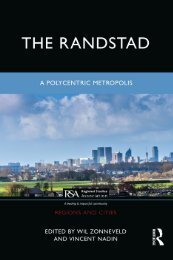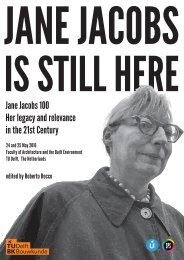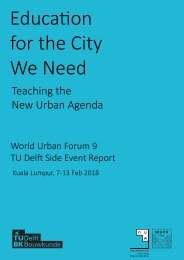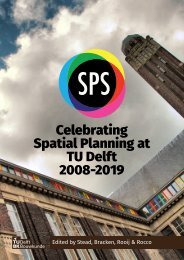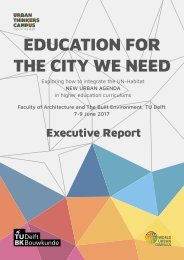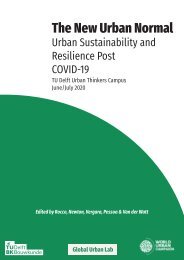A Manifesto for the Just City
On Monday 29 MARCH at 18:00 (CET/Amsterdam), TU Delft launched the Book "A Manifesto for the Just City", with texts by a number of guests and 43 manifestos written by students from 25 universities from all over the world. A “Manifesto for the Just City” comes in the wake of the realisation that socio-spatial justice is a crucial dimension for sustainability transitions. Growing inequality and the erosion of the public sphere undermine the social and political structures required to fight climate change, pandemics and other systemic shocks. With this book, we have sought to encourage students to formulate their own visions for the Just City and for a just transition. This book is result of an Urban Thinkers Campus organised between 9 and 30 November 2020. The Urban Thinkers Campus (UTC) model is an initiative of UN-Habitat’s World Urban Campaign, conceived in 2014 as an open space for critical exchange between stakeholders and partners. It aims to promote debate and action on sustainable and inclusive urbanization upholding the principles and guidelines contained in the New Urban Agenda, launched at Habitat-III in 2016 in Quito, Ecuador.
On Monday 29 MARCH at 18:00 (CET/Amsterdam), TU Delft launched the Book "A Manifesto for the Just City", with texts by a number of guests and 43 manifestos written by students from 25 universities from all over the world.
A “Manifesto for the Just City” comes in the wake of the realisation that socio-spatial justice is a crucial dimension for sustainability transitions. Growing inequality and the erosion of the public sphere undermine the social and political structures required to fight climate change, pandemics and other systemic shocks. With this book, we have sought to encourage students to formulate their own visions for the Just City and for a just transition.
This book is result of an Urban Thinkers Campus organised between 9 and 30 November 2020. The Urban Thinkers Campus (UTC) model is an initiative of UN-Habitat’s World Urban Campaign, conceived in 2014 as an open space for critical exchange between stakeholders and partners. It aims to promote debate and action on sustainable and inclusive urbanization upholding the principles and guidelines contained in the New Urban Agenda, launched at Habitat-III in 2016 in Quito, Ecuador.
Create successful ePaper yourself
Turn your PDF publications into a flip-book with our unique Google optimized e-Paper software.
A <strong>Manifesto</strong> <strong>for</strong> <strong>the</strong> <strong>Just</strong> <strong>City</strong><br />
16 // 276<br />
CAROLINE NEWTON, ASSOCIATE PROFESSOR OF SPATIAL PLANNING & STRATEGY, TU DELFT.<br />
VAN EESTEREN FELLOW.<br />
The summer of 2020 was one of <strong>the</strong> warmest<br />
summers ever recorded in Belgium and<br />
<strong>the</strong> 12-day heatwave <strong>the</strong> longest ever. And<br />
precisely during this time, <strong>the</strong> province’s<br />
governor took extra measures to fight <strong>the</strong> rising<br />
corona numbers. On my way to <strong>the</strong> supermarket,<br />
driving on one of Flanders infamous approach roads,<br />
I saw a young mo<strong>the</strong>r sitting outside her house. Next<br />
to her was a toddler having fun in a paddling pool.<br />
The cars passed near <strong>the</strong>m, maybe only half a meter<br />
away. This scene reminded<br />
me of how different people’s<br />
possibilities and chances<br />
are. I was thinking of my<br />
own children: also enjoying<br />
a refreshing dip in our very<br />
own paddling pool. The<br />
difference is that <strong>the</strong>y were<br />
doing this in our enclosed<br />
private garden, far away<br />
from <strong>the</strong> passing cars noise<br />
and pollution.<br />
GLIMPSES<br />
OF THE<br />
FUTURE<br />
As Soja (2010, p. 56) pointed<br />
out, geographically uneven development has always<br />
existed. And indeed, looking at history, we know<br />
that cities were built along rivers or emerged at <strong>the</strong><br />
intersection of roads. A castle on <strong>the</strong> mountainside<br />
overlooking <strong>the</strong> valley gave <strong>the</strong> lord of <strong>the</strong> land<br />
an incredible advantage because he could see <strong>the</strong><br />
enemy approaching miles away. Humans started to<br />
occupy space in different ways, consolidating <strong>the</strong><br />
unequal relationships between <strong>the</strong>m. These unequal<br />
relations exist on several scales, from <strong>the</strong> very local to<br />
<strong>the</strong> global level, whereby <strong>the</strong> unequal appreciation of<br />
areas is emphasised by <strong>the</strong> terminology used. The socalled<br />
‘Global North’ is referred to as <strong>the</strong> developed<br />
world. It is characterised by having world-class cities<br />
full of innovation. In contrast, <strong>the</strong> Global South is<br />
framed as <strong>the</strong> developing world. Its numerous megacities<br />
filled with chaos and in<strong>for</strong>mality....<br />
to a fur<strong>the</strong>r handing over of <strong>the</strong> organisation of urban<br />
life to <strong>the</strong> market. To illustrate, <strong>the</strong> refugee crisis<br />
in <strong>the</strong> US has caused <strong>the</strong> entire refugee detention<br />
organisation to be managed by private companies.<br />
A perverse effect arises as <strong>the</strong>se companies earn<br />
money by keeping people in detention <strong>for</strong> as long<br />
as possible and under [in] “humane” circumstances.<br />
All incentives <strong>for</strong> rapid qualitative integration into<br />
society are removed.<br />
Un<strong>for</strong>tunately, spatial<br />
planning also seems to have<br />
evolved into a neo-liberal<br />
practice, focused exclusively<br />
on enabling development<br />
and investment instead<br />
of empowering citizens.<br />
Cities use large scale<br />
redevelopments,<br />
neighbourhood upgrading<br />
and iconic architecture to<br />
compete with o<strong>the</strong>r cities<br />
to attract international<br />
companies, more investors<br />
and high-income residents. Our space has become<br />
nothing more than a commodity. The value of which<br />
is influenced by location and expressed in money,<br />
determining <strong>the</strong> possibilities <strong>for</strong> investments and<br />
fur<strong>the</strong>r developments.<br />
O<strong>the</strong>r characteristics, such as air quality, noise, or<br />
smell, are intrinsically linked to location in <strong>the</strong> city<br />
and often en<strong>for</strong>ce <strong>the</strong> attached value. Those living<br />
in <strong>the</strong> more affluent urban neighbourhoods often<br />
enjoy less nuisance from noise or smell or better air<br />
quality and better access to services. The fragile and<br />
vulnerable groups of homeless or urban poor have<br />
to settle in unhealthy areas that suffer from health<br />
disadvantages. These conditions affect <strong>the</strong> physical<br />
and mental health of already vulnerable population<br />
groups.<br />
But when we look closer, we see that in reality,<br />
inequality is growing in <strong>the</strong> Global North, while we<br />
can find more and more social innovations in <strong>the</strong><br />
Global South.<br />
On <strong>the</strong> local level, social inequalities are increasingly<br />
anchored in space, making change difficult and<br />
emancipation challenging.<br />
More than ever, our cities’ historical diversity and<br />
inclusiveness are under pressure. Moreover, <strong>the</strong><br />
crises we are facing today are conducive to fur<strong>the</strong>r<br />
segregation and oppression. Ra<strong>the</strong>r than being a<br />
wake-up call to review <strong>the</strong> current state of affairs<br />
in civil society, crises today seem to encourage a<br />
conservative attitude, whereby claims <strong>for</strong> austerity<br />
and reducing <strong>the</strong> state’s role gain acceptance, leading<br />
As Soja has argued (2010, p. 73) being differently<br />
located in space can have “deeply oppressive and<br />
exploitative effects, especially when maintained over<br />
long time periods and rooted in persistent divisions<br />
in society such as those based on race, class, and<br />
gender.” The additional effects of <strong>the</strong>se unjust<br />
embodied experiences impact vulnerable groups’<br />
possible emancipation. Also, <strong>the</strong>y influence <strong>the</strong> city’s<br />
liveability and <strong>the</strong> attractiveness of urban life as a<br />
whole. In this era, where cities are considered as <strong>the</strong><br />
panacea of all ills caused by climate change, we can<br />
no longer allow that <strong>the</strong> urban organisation limits <strong>the</strong><br />
enjoyment of urban life <strong>for</strong> some, while it supports to<br />
full use and pleasure of o<strong>the</strong>rs. As a global society,<br />
we can only move <strong>for</strong>ward if we move <strong>for</strong>ward with<br />
everyone and leave no one behind. Thus, what we<br />
need is a <strong>Just</strong> <strong>City</strong> that creates opportunities <strong>for</strong> all


